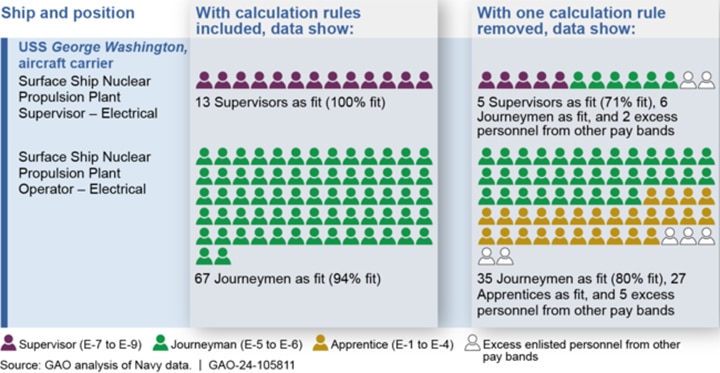
Image: GAO
Crewing ships with an adequate number of personnel who have the right skills and experience is vital for executing missions and mitigating risks. However, says a new report from the U.S. Government Accountability Office (GAO) “the Navy has historically assigned fewer crewmembers to ships than are required to operate them safely. Such crewing shortfalls contributed to the fatal Navy surface ship collisions in 2017.”
Navy officers face charges following destroyer collisions
The GAO says that the Navy uses data to measure its crewing target levels and monitor personnel readiness. These data are called fill and fit metrics. Fill metrics measure the number of personnel onboard a ship. Fit metrics measure the skill, experience, and specialty skills of personnel. However, the data are not sufficiently reliable or transparent. Specifically, GAO found that the Navy applies some calculation rules to this data that result in counting some junior enlisted sailors as filling positions that require more senior-level sailors. For example, with one calculation rule removed, the number of fit sailors in positions linked to nuclear-powered ships fell (see figure). Until the Navy removes these calculation rules, it will continue to rely on data that does not provide an accurate understanding of the true extent of the skill and experience gaps across the fleet.

The Navy does not consistently use validated personnel requirements to inform decisions. Personnel requirements identify the sailor positions and the specific skill levels needed to perform the Navy’s work. Navy Manpower Analysis Center (NAVMAC) determines and validates personnel requirements through periodic workload studies for ships to ensure these requirements reflect the right number and mix of positions needed to support Navy operations. These validated requirements should be used to inform funding decisions. However, GAO found that personnel requirements data in the Navy’s authoritative system was sometimes lower and sometimes higher than validated requirements. Several issues contribute to limitations in the reliability of the Navy’s requirements data. For example, Navy guidance does not clearly specify that only NAVMAC can validate changes to these requirements. As a result, the Navy may rely on unvalidated requirements during its annual process to inform funding decisions. Until the Navy updates relevant guidance to clarify what specific sources it can rely on to present validated personnel requirements, it cannot ensure that it is making decisions about personnel funding based on accurate information.
A House Report includes a provision for GAO to review the Navy’s ship crewing efforts. Among other things, GAO assessed the extent to which the Navy uses data that reflect accurate crewing levels and validates personnel requirements to make informed funding and crewing decisions.
GAO reviewed policies and guidance for crewing personnel to ships, compared and analyzed fill and fit metric and personnel requirements data from fiscal years 2018 through 2023, and interviewed Navy officials. GAO also conducted small group discussions with enlisted sailors and leadership from seven ships.
GAO is making 11 recommendations to improve the reliability and management of Navy ship crewing data. These include removing calculation rules that allow junior sailors to count as filling positions of senior sailors, and updating guidance to specify that only NAVMAC can validate changes to personnel requirements. In written comments, the Navy concurred with six recommendations, partially concurred with two, and did not concur with three. GAO continues to maintain that all of its recommendations are warranted.
Read the recommendations HERE
Download the full report HERE





